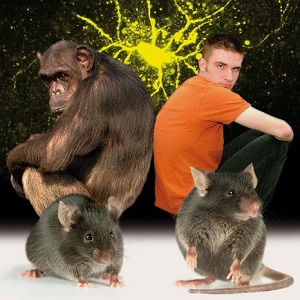Contact
Email:
enard@bio.lmu.de
Primate Genomics, Evolutionary Biology, Computational biology

Our goal is to understand the molecular basis of human evolution, including its implications for biomedical questions. A core expertise of our group in this context is bridging the gap between evolutionary genomics and experimentally approachable molecular mechanisms. We study the role of the transcription factor Foxp2 in human speech evolution using a mouse model and are studying the involved regulatory networks using RNA-Seq, ChiP-Seq and proteomics [1-4]. We also investigate the genetic basis of brain size evolution by correlating genetic changes with changes in brain size across primates and mammals to guide further experimental approaches [5, 6]. Finally, we generate and analyze induced pluripotent stem cells (iPSCs) from primates to investigate the evolution of human regulatory networks and to experimentally manipulate them [7, 8]
1. Schreiweis*, C., Bornschein*, U., Burguiere, E., Kerimoglu, C., Schreiter, S., Dannemann, M., Goyal, S., Rea, E., French, C.A., Puliyadi, R., et al. (2014). Humanized Foxp2 accelerates learning by enhancing transitions from declarative to procedural performance. Proc Natl Acad Sci U S A 111, 14253-14258.
2. Enard, W. (2014). Mouse models of human evolution. Curr Opin Genet Dev 29C, 75-80.
3. Enard, W. (2011). FOXP2 and the role of cortico-basal ganglia circuits in speech and language evolution. Current opinion in neurobiology 21, 415-424.
4. Enard, W., Gehre, S., Hammerschmidt, K., Holter, S.M., Blass, T., Somel, M., Bruckner, M.K., Schreiweis, C., Winter, C., Sohr, R., et al. (2009). A humanized version of Foxp2 affects cortico-basal ganglia circuits in mice. Cell 137, 961-971.
5. Enard, W. (2014). Comparative genomics of brain size evolution. Frontiers in human neuroscience 8, 345.
6. Fietz, S.A., Lachmann, R., Brandl, H., Kircher, M., Samusik, N., Schroder, R., Lakshmanaperumal, N., Henry, I., Vogt, J., Riehn, A., et al. (2012). Transcriptomes of germinal zones of human and mouse fetal neocortex suggest a role of extracellular matrix in progenitor self-renewal. Proc Natl Acad Sci U S A 109, 11836-11841.
7. Wunderlich, S., Kircher, M., Vieth, B., Haase, A., Merkert, S., Beier, J., Gohring, G., Glage, S., Schambach, A., Curnow, E.C., et al. (2014). Primate iPS cells as tools for evolutionary analyses. Stem Cell Research 12, 622-629.
8. Enard, W. (2012). Functional primate genomics-leveraging the medical potential. J Mol Med (Berl) 90, 471-480.
http://anthropologie.bio.lmu.de/research/primate-genomics/index.html


